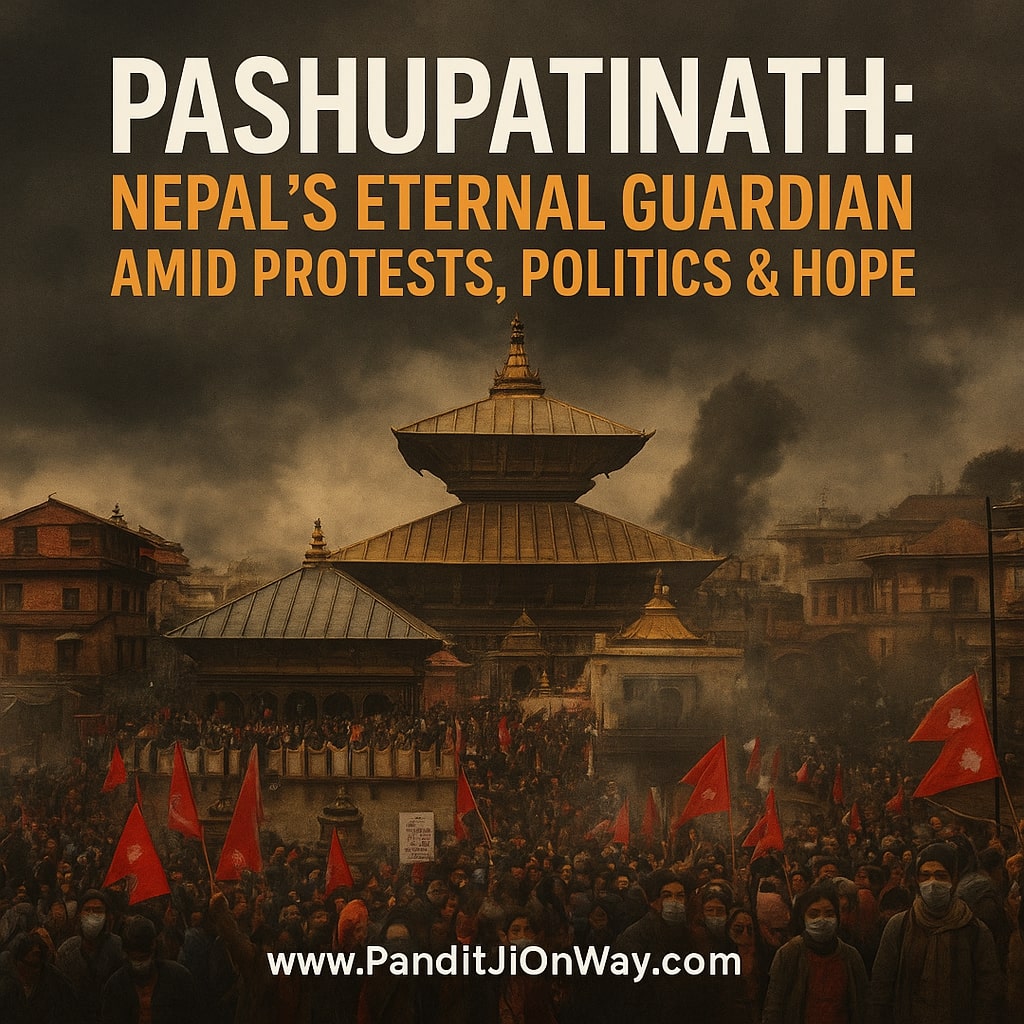Pashupatinath: Nepal’s Eternal Guardian Amid Crisis and Hope
“नेपालको आत्मा जहाँ बस्छ, त्यहाँ पशुपतिनाथ सधैं साक्षी छन्।”
“Where the soul of Nepal resides, Pashupatinath always stands witness.”
Nepal in 2025 is at a crossroads. From massive Gen Z protests against corruption and unemployment, to pro-monarchy demonstrations challenging the republic system, and ongoing economic struggles from inflation and migration, the country faces deep uncertainties. Amid all this turmoil, one force continues to unite people — Lord Pashupatinath, the eternal saviour, spiritual anchor, and guardian of Nepal’s destiny.

Nepal’s Current Challenges in 2025
- Gen Z Uprising: Young protesters across Kathmandu and major cities demand jobs, justice, and an end to corruption. Their slogan “नयाँ नेपाल, नयाँ पुस्ता” (New Nepal, New Generation) captures the spirit of reform.
- Monarchy vs Republic: Pro-monarchy rallies highlight growing disillusionment with federal democracy. Pashupatinath, however, transcends politics, remaining a sacred meeting ground for all sides.
- Economic Strain: Heavy reliance on remittances, youth migration, and inflation have shaken families across Nepal. Temples like Pashupatinath offer spiritual relief when financial stress grows unbearable.
- Disaster Vulnerability: Floods and landslides during monsoons continue to test resilience. During such crises, devotees pray at Pashupatinath for protection and strength.
Pashupatinath: The Divine Constant Beyond Politics
While governments change and policies falter, Pashupatinath remains the true constant in Nepali life.
1. A Common Identity in Division
Amid monarchy-republic debates, Pashupatinath is the one space where both sides bow their heads together. Devotion overrides division.
👉 “When leaders argue, I still feel peace at Pashupatinath. Politics cannot divide Mahadev.” — Madhav, 29, Kathmandu
2. Festivals as National Healing
Despite unrest, Maha Shivaratri 2025 drew over a million devotees. All four gates opened before dawn, security was tightened, and communities provided free meals. The same unity was seen during Shrawan Mondays when thousands carried kanwar with holy water, chanting “Har Har Mahadev.”
👉 “During Shrawan, our faith is stronger than politics. Even in hardship, we walk barefoot for Mahadev.” — Ram Bahadur, farmer, Chitwan
3. Youth, Protest, and Prayer
Even Gen Z activists visit Pashupatinath after protests. Many link their fight for justice with spiritual values of dharma (righteousness) and truth, drawing strength from Mahadev.
4. International Symbolism
When six former Indian Army Chiefs attended Maha Shivaratri at Pashupatinath in 2025, it highlighted Nepal’s soft power — its spirituality influencing beyond borders.
Case Studies: Faith in Action
- Maha Shivaratri 2025: Over 1 million devotees, free medical aid, security arrangements, and cultural programs underscored Nepal’s ability to unite under faith despite political turmoil.
- Gen Z Protests (2025): After days of demonstrations, many young activists were seen offering prayers at Pashupatinath, seeking guidance for their cause.
- Cleaning Campaigns: Weekly temple-area clean-ups by police and locals symbolize how spirituality translates into civic responsibility.
Why Pashupatinath is Nepal’s Saviour Today
- Moral Compass in Uncertain Politics — reminds leaders and citizens of higher values.
- Psychological Anchor Amid Protests — a safe space when the streets are filled with unrest.
- Economic Support Through Tourism — festivals generate income for local vendors during hard times.
- Unifying Force Across Generations — both monarchists and republicans, youth and elders, meet in devotion here.
Conclusion: Faith Stronger Than Politics
Nepal’s parliament may debate, protests may continue, and the economy may struggle — but Lord Pashupatinath remains the eternal guardian. His temple is not about politics, but about faith, unity, and hope. For millions, chanting “जय पशुपति” is the reminder that no matter how turbulent the times, Nepal’s spiritual soul will never be shaken.
Frequently Asked Questions (FAQ)
Q1: Why is Lord Pashupatinath called the “Saviour of Nepal” during crises?
A: Lord Pashupatinath is worshipped as the eternal guardian of Nepal. In times of political instability, economic slowdown, natural disasters, or recent youth protests, devotees believe that the deity protects the nation and provides spiritual strength when human leadership falters.
Q2: How is Pashupatinath connected to Nepal’s Prime Ministers and politics?
A: It is a tradition for every newly appointed Nepal Prime Minister to visit Pashupatinath Temple for blessings before beginning their tenure. Even in 2025, amid coalition challenges, leaders continue this ritual, symbolizing that governance in Nepal requires not just political strategy but divine guidance.
Q3: Did the Pashupatinath Temple remain safe during Nepal’s earthquakes?
A: Yes. During the 2015 Nepal earthquake, the main sanctum of the Pashupatinath Temple stood strong while many nearby structures collapsed. This miracle reinforced people’s faith that Lord Pashupatinath protects the country from complete devastation.
Q4: What is the role of Pashupatinath during Nepal’s recent economic and social struggles?
A: In 2025, as Nepal faces high youth unemployment, migration, and inflation, the temple remains a spiritual anchor. Thousands gather daily to pray for stability, peace, and opportunities, proving that faith in Pashupatinath continues to unite the nation across generations.
Q5: When is the best time to visit Pashupatinath Temple in 2025?
A: The temple is open year-round, but the most powerful time to visit is during Maha Shivaratri 2025 (March), when millions of devotees and sadhus gather in Kathmandu. Other significant dates include Teej, Bala Chaturdashi, and Kartik Purnima.
Q6: Where can I learn about daily pujas, aartis, and rituals at Pashupatinath?
A: For updated schedules, festivals, and authentic rituals, you can check the official temple trust announcements. You can also explore detailed guidance on priests, pujas, and darshan timings at Pashupatinath Temple – PanditJiOnWay.
Want to experience authentic rituals at Pashupatinath or book priests for your own puja? Visit PanditjiOnWay for trusted guidance.


